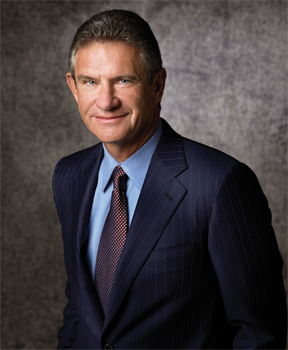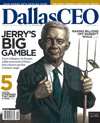It was 1968 in Ann Arbor, Michigan, and the social upheaval of the decade had trickled down into commercial real estate. Landlords and renters were at loggerheads. Rent strikes, particularly in the North and the Midwest, were commonplace. Craig Hall, then 17 with $4,000 ready to invest, saw something. Two things, really. One was an opportunity to make a profit. The other was that, in his view, the renters were in the right. So with money he’d saved from odd jobs since childhood, he bought his first commercial property—a low-rent rooming house.
“Nobody was investing in real estate at the time because there was this huge tenant/landlord fight and the rent strikes. It seemed like a good thing to go against the grain, but I also thought the landlords were not being fair. I thought I could go in and treat people fairly and still make a profit,” Hall says. Soft-spoken in a simple, crisp white dress shirt, sipping on a fruit smoothie, Hall exudes a Midwest modesty at odds with the shadow he casts. “I haven’t changed either of those philosophies.”
It worked then—Hall became a major player in apartment ownership and management in the 1970s and 1980s—and it’s working for him today. His tenants may have changed—fewer eviction-prone peaceniks and more corporations—but his philosophy never has.
Be it real estate, stocks, wine, hotels, or software, the sector doesn’t matter to Hall. He takes the same approach to anything that catches his interest: do your due diligence, do what you think is right, and if everyone else is doing something different then you’re probably on the right track. The approach has augured well. His Hall Financial Group, the private investment firm he helms with more than $1 billion in holdings, was born of those humble beginnings. And Hall Office Park, built when Frisco was nothing but scattered rooftops and trees, has become an award-winning commercial real estate success.
“I’m just trying to be where the edge comes from working harder and working smarter and taking risk,” Hall says. “People say, ‘Buy low and sell high,’ but they don’t do it. It’s easy to say and sounds like a good idea, but it’s very hard for people to buy when nobody wants to buy and sell when everything seems so great.”
It’s fair to say at a glance there’s nothing about Hall that fits the mythic mold of the Texas developer. He’s not physically imposing. He’s not loud or flashy or brash. He’s not politically conservative. In many ways he’s downright meticulous, as comfortable talking about the nuances of wine, abstract art, and progressive politics as he is finance and market caps. And, told in retrospect, he’s very comfortable talking about Hall Office Park. In 1989, he started buying land in Frisco when spending cash was scarce. His company, like so many other real estate firms at the time, was in survival mode.
“That was still at a time when we were in financial trouble on a relative basis. Our financial downturn was lengthy and yet we weren’t completely dead in the water,” he says, sitting in his Spartan office. It’s an impossibly tidy workspace in a building that anchors the 162-acre office park. “What attracted me to this site was the ability to have a large enough piece of land in a growth corridor where you could do something different than the normal short-term mentality of building a building and selling it.”
Hall says that during this time, well before terms like New Urbanism and “lifestyle development” were in vogue, he was increasingly put off by the kind of office product he saw being built: bland glass boxes surrounded by a sea of parking lots. “Conceptually we wanted to redefine the work environment and do it in a way that made the suburban office product more of a real pleasant environment and pleasant space with the lakes and the art,” he says.
Lenders weren’t as enthusiastic. Following his gut and opening his wallet, Hall broke ground on Hall Office Park in 1997. Consequently, and by design, all of the construction funding for Hall Office Park came entirely out of Hall’s own pocket. With 11 nearly leased-up buildings totaling 1.5 million square feet, there’s still room for another 1.5 million square feet of planned space. But even half built-out, Hall Office Park is a nationally recognized property that has won real estate industry awards for service and design. The lakes, fountains, fitness center, pedestrian-friendly design, greenbelts, walking trails, and outdoor art that mark the property are de rigueur for developers now, but a decade ago it was an oddity.
“He has that habit of going against the conventional wisdom. What he does seems to become the trend for others to follow later,” says Michael A. Jenkins, president of Dallas-based Leisure and Recreation Concepts and longtime friend of Hall. Jenkins’ company is designing the interactive experience for visitors to the Frank Gehry-designed welcome center and the restored historic buildings at Hall Vineyards in St. Helena, California, in the Napa Valley region. “It’s going to be like nothing else in wine country.”
The contrarian strategy permeates almost everything Hall touches. He bought nearly 8 percent of American Airlines parent AMR Corp. when the stock was mired in single digits. He invested in hotels in mid-2002, when the hospitality industry was at its nadir in the wake of the September 11 attacks. He invested in vineyards when most people couldn’t sell their wine holdings fast enough. (Now his growing vineyard portfolio totals 3,300 acres, 500 of which are planted, and his label’s vintages have earned rave reviews.) Hall even bought a million shares of RadioShack in February 2006 when CEO David Edmondson was forced to resign over his fraudulent résumé.
“That’s what we do. I could be wrong. I did a lot of research on it, but I still could be wrong. I’m the first to admit that I am taking risks,” Hall says. “I think it’s better to take risks at an off time at a low price if you do your homework and you think you understand it than it is to follow the crowd and buy at the top and hope it will keep going up. I have trouble with that but that’s what most people do.”
Not that everything Hall has touched has come up roses. His losses and troubles in the early 1990s were legendary. The sire of a $5 billion real estate empire in the late 1980s, he filed chapter 11 in 1992. Some in the real estate industry were less than supportive. Said one long-time Dallas developer and investor, “There was a time I’d just as soon not be behind the wheel when Craig Hall was crossing the street.” Guilt by association? In his defense, Hall contributed millions out of pocket to affiliated partnerships to cover negative operations, and he notified his investors and lenders of potential defaults before anyone else would admit problems were on the way.
On a recent Friday afternoon, he gazes out of his window at the development that bears his name. In the long run, Hall wants to finish the park out and sell it to an institutional investor. A property like this needs the attention he can’t bring to a stable, finished asset. He wants to continue finding and exploiting the “niches of inefficiency” in an increasingly securitized and stabilized commercial real estate market. He likes the margins where there’s less rigidity and more opportunity—more risk and more payoff.
“I’m an entrepreneur. I like risk. I don’t like to do the same thing over and over. I might be a whole lot smarter and richer—like Michael Dell—if I had done the same thing. It becomes hard for me to stay engaged in something like that,” he says. “It’s hard to find the niches but that’s what we look for—the niches where other people aren’t. If the market tells us the opportunity is drying up, we move on.”
Into the sunset.






